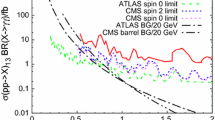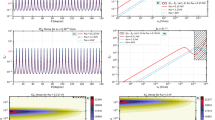Summary
Two events are described in which heavy mesons interact with nuclei in photographic emulsions, producing small stars and emerging themselves from the collisions. In one example, a relativistic singly charged particle enters the stack and produces a star with only three emergent charged particles, which have been identified as a hyperon, a π-meson and a K-meson respectively. The K-meson creates two stars before it comes to rest and decays with the emission of a slow μ-meson. In the other example, a K-meson enters the stack from outside and, after interacting, comes to rest within the emulsion and decays with the emission of a single lightly ionizing particle. Certain features of interest associated with the scattering properties of heavy mesons are discussed.
Riassunto
Si descrivono due eventi in cui mesoni pesanti interagiscono con nuclei dell’emulsione fotografica producendo piccole stelle ed emergendo essi stessi dalla collisione. In uno degli eventi una particella relativistica dotata di carica semplice entra nel pacco e produce una stella con sole tre particelle cariche emergenti che sono state identificate con un iperone, un mesone π e un mesone K, rispettivamente. Il mesone K produce due stelle prima di arrestarsi e decade con l’emissione di un mesone μ lento. Nell’altro evento un mesone K penetra nel pacco dall’esterno e, dopo aver interagito, si arresta nell’emulsione e decade con l’emissione di un’unica particella debolmente ionizzante. Si discutono alcuni interessanti particolarità riguardanti le proprietà dello scattering dei mesoni pesanti.
Similar content being viewed by others
References
C. O’Ceallaigh:Phil. Mag.,42, 1032 (1951).
C. Dahanayake, P. E. Francois, Y. Fujimoto, P. Iredale, C. J. Waddington andM. Yasin:Phil. Mag., (1955) in course of publication.
P. H. Fowler andD. H. Prekins:Phil. Mag. (1955), in course of publication.
R. R. Daniel andD. Lal:Proc. Ind. Acad. Sci., in course of publication (1955).
M. Gell-Mann andA. Pais:Proc. Int. Nucl. Phys. Conf. (Glasgow), July 1954.
D. Lal, Yash Pal andB. Peters:Phys. Rev.,92, 438 (1953).
J. Crussard, M. F. Kaplon, J. Klarmann andJ. H. Noon:Phys. Rev.,95, 584 (1954).
G. Goldhaber:Proc. Rochester Conference on High Energy Physics (1955).
M. W. Friedlander, D. Keefe, M. G. K. Menon, R. H. W. Johnston, C. O’Ceallaigh andA. Kernan:Phil. Mag.,46, 144 (1955).
Author information
Authors and Affiliations
Additional information
The nomenclature K-meson andℵ-meson are used throughout in the sense ofPowell (Proc. Roy. Soc., A221, 278 (1954)), i.e. the term K-meson refers to any particle with a mass intermediate between those of the π-meson and the proton, andx-meson is a K-meson which decays with the emission of a μ-meson and at least two neutral particles.
Rights and permissions
About this article
Cite this article
Friedlander, M.W., Keefe, D. & Menon, M.G.K. The interaction of fast K-mesons. Nuovo Cim 1, 694–704 (1955). https://doi.org/10.1007/BF02855228
Received:
Published:
Issue Date:
DOI: https://doi.org/10.1007/BF02855228




